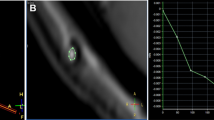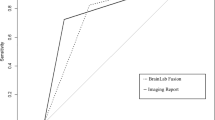Abstract
Introduction
3-Tesla (T) magnetic resonance imaging (MRI) offers high resolution imaging with improved signal quality. It also allows for improved functional investigations, most prominently with respect to fiber tracts and their relation to pathological lesions. Up to now, patients with adjustable shunt systems were not eligible for high field power magnetic resonance imaging. We have evaluated the effects of this technique upon a newly developed adjustable shunt valve.
Method
Ten adjustable shunt devices were examined during routine and functional 3-T high field MRI examinations. Pressure settings were checked after 17 examinations each for all valves. There were no changes in pressure setting at all possible levels in any of the tested devices. No problems with the adjusting mechanism were observed during 340 examinations.
Conclusion
This new shunt device offers the diagnostic benefit of high field magnetic resonance imaging in shunt-dependent patients who need an adjustable valve. The valve is not affected by higher magnetic field power and does not require readjustment of the pressure settings after MRI examination.



Similar content being viewed by others
References
Briellmann RS, Syngeniotis A, Jackson GD (2001) Comparison of hippocampal volumetry at 1.5 tesla and at 3 tesla. Epilepsia 42:1021–1024
Briellmann RS, Pell GS, Wellard RM, Mitchell LA, Abbott DF, Jackson GD (2003) MR imaging of epilepsy: state of the art at 1.5 T and potential of 3 T. Epileptic Disord 5:3–20
Chen W, Ugurbil K (1999) High spatial resolution functional magnetic resonance imaging at very-high-magnetic field. Top Magn Reson Imaging 10:63–78
Nobauer-Huhmann IM, Ba-Ssalamah A, Mlynarik V, Barth M, Schoggl A, Heimberger K, Matula C, Fog A, Kaider A, Trattnig S (2002) Magnetic resonance imaging contrast enhancement of brain tumors at 3 tesla versus 1.5 tesla. Invest Radiol 37:114–119
Pollack IF, Albright AL, Adelson PD (1999) A randomized, controlled study of a programmable shunt valve versus a conventional valve for patients with hydrocephalus. Hakim–Medos Investigator Group. Neurosurgery 45:1399–1408
Thulborn KR, Chang SY, Shen GX, Voyvodic JT (1999) Clinical rationale for very-high-field (3.0 Tesla) functional magnetic resonance imaging high-resolution echo-planar fMRI of human visual cortex at 3.0 tesla. Top Magn Reson Imaging 10:37–50
Trattnig S (2002) 3D Tesla magnetic resonance tomography—clinical applications. Wien Med Wochenschr 13 [Suppl 1]:22–27
Zemack G, Romner B (2002) Adjustable valves in normal-pressure hydrocephalus: a retrospective study of 218 patients. Neurosurgery 51:1392–1400
Acknowledgements
We thank Steffie Dieke for assistance with photographic documentation.
Author information
Authors and Affiliations
Corresponding author
Additional information
The authors have no financial interest in the subject discussed
Rights and permissions
About this article
Cite this article
Lüdemann, W., Rosahl, S.K., Kaminsky, J. et al. Reliability of a new adjustable shunt device without the need for readjustment following 3-Tesla MRI. Childs Nerv Syst 21, 227–229 (2005). https://doi.org/10.1007/s00381-004-1084-2
Received:
Published:
Issue Date:
DOI: https://doi.org/10.1007/s00381-004-1084-2




